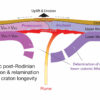Glaciers in tropical mountain ranges are experiencing similar impact from the drivers of climate change as those in the polar regions of Antarctica and the Northern Hemisphere, according to a study published today in Nature.
The paper by a team of international scientists, including Robert Hatfield, an assistant professor in the University of Florida Department of Geological Sciences, is the first to show that the effects of greenhouse gases and other drivers of the Earth’s temperature are impacting glaciers in the Southern Hemisphere at the same pacing as ice sheets in the north. To derive their findings, researchers used sedimentary deposits from Lake Junín, high in the Peruvian Andes, to create a record of glacial changes stretching back 700,000 years.
Hatfield explained that much of what scientists knew about past glacial changes came from records of ice growth and decay that occurred in the Northern Hemisphere.
“As we try to understand how climate works across the globe, we need more than just records that are influenced by and biased toward the Northern Hemisphere,” Hatfield said.
The land-based lake record collected by Hatfield and his colleagues matches the duration of ice core records from Antarctica and spans the longest time frame ever collected from the Southern Hemisphere.
“What makes our findings unique is that we were able to get a continuous and independently dated record of tropical Alpine glaciation for the first time,” he said. “The key takeaway was that the tropics follow the same beat and same rhythm to what’s going on in the Northern Hemisphere.”
Despite variations in solar radiation between the two hemispheres, the study showed glacier changes in both regions occurred at the same time. This suggests that the rise in atmospheric greenhouse gas concentrations associated with changes in the volume of the ice sheets of the north is influencing the entire planet simultaneously.
When glaciers were extensive in the high Andes, they eroded the mountains around them, sending sediment contained in meltwater to Lake Junín. In warmer times when the glaciers were absent, carbonate was deposited in the lake instead.
To collect their data, geologists launched a massive drilling mission at the lake in 2015, funded by the National Science Foundation and International Continental Scientific Drilling Program. Working around the clock for seven weeks, the group


